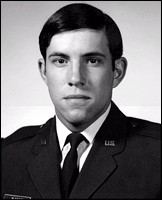Ending a painful mystery surrounding Arlington National Cemetery’s Tomb of the Unknowns, Pentagon officials revealed yesterday that the remains of the memorial’s Vietnam War soldier belong to Air Force pilot Michael J. Blassie.

The disclosure is the culmination of a controversy that brought one of the most powerful American symbols of sacrifice into conflict with the broken hearts of several military families. Blassie’s relatives, aching to know what happened to their loved one after his plane was shot down 26 years ago over Vietnam, appealed to top military officials to use new DNA identification techniques to test the unknown soldier, even if it meant taking the extraordinary step of disturbing the tomb’s sanctity.
Members of the family of another soldier who could have been the unknown, Army Capt. Rodney Strobridge, said they were notified yesterday by a senior Pentagon official that DNA samples from bones removed from the tomb have been found to match the DNA of Blassie, an Air Force lieutenant.
For Strobridge’s loved ones, the disclosure was bittersweet.
“It would be nice to have closure, but I’m very happy for the Blassie family and hope that they have closure now,” said Pat Baker, a Burke resident who was married to Strobridge when the helicopter pilot was shot down.
A Pentagon official, who asked not to be identified, confirmed yesterday that the remains are Blassie’s and said that Secretary of Defense William S. Cohen is planning to announce it today.
Members of Blassie’s family could not be reached immediately for comment yesterday.
Blassie, 24, an Air Force Academy graduate and the oldest of the five children of a St. Louis meat cutter, was flying an A-37 when he was shot down over An Loc, about 60 miles north of Saigon in South Vietnam, on May 11, 1972.
The military initially classified remains discovered near An Loc as “believed to be” those of Blassie because they had been recovered with his military identification card, parachute and other evidence indicating they had come from an A-37 crash.
But laboratory testing in Hawaii found that the remains did not match Blassie’s physical measurements. The results of the blood type test did fit Strobridge, although there was not enough other evidence to declare a positive identification.
So the remains were reclassified as unknown. During an emotional Memorial Day ceremony presided over by President Ronald Reagan in 1984, the remains were interred in the Tomb of the Unknowns.
But Blassie’s family never accepted that his body could not be identified, and they pressed for a disinterment. After a lengthy debate and a review of the case earlier this year by a Pentagon panel, Cohen ordered the exhumation in May. After a solemn ceremony, six bones were removed from the tomb for DNA sampling.
Tests were performed at the Armed Forces DNA Identification Laboratory in Rockville and the Armed Forces Institute of Pathology at Walter Reed Army Medical Center in Washington. Two weeks ago, Pentagon officials announced that DNA samples collected would be adequate to make an identification.
For the Strobridge family, the mystery of what happened to their loved one remains.
“I think in our case, they’ve exhausted all the leads, so I don’t think we’ll ever know,” said Baker. “It’s been 26 years, so it would be nice to know.”
“I’m glad the Blassies are going to be happy,” Althea Strobridge, mother of the missing soldier, said yesterday in a telephone interview from her home in Perry, Iowa.
“I could cry, but I don’t want to cry,” Strobridge said.
She said she took comfort from the fact that her son’s name is listed on a marker at Arlington Cemetery of those missing in action.
“It seems like he’s there, anyway,” Strobridge said.
Eight other servicemen were possible candidates for being the unknown soldier, although one of the eight had no living relative to provide a DNA sample. Military officials yesterday were trying to contact all the families, along with those of Blassie and Strobridge, with the results of the testing, an official said.
Still unclear is what will happen with the tomb itself and whether the remains of another unidentified soldier from Vietnam will be interred in the memorial in place of Blassie.
“That’s an unknown,” a Pentagon official said last night. “With the state of technology, it’s going to become ever more difficult.”
The tomb, which is under 24-hour ceremonial guard, also holds the remains of unknown soldiers from World War I, World War II and the Korean War.
Michael Robert Patterson was born in Arlington and is the son of a former officer of the US Army. So it was no wonder that sooner or later his interests drew him to American history and especially to American military history. Many of his articles can be found on renowned portals like the New York Times, Washingtonpost or Wikipedia.
Reviewed by: Michael Howard
